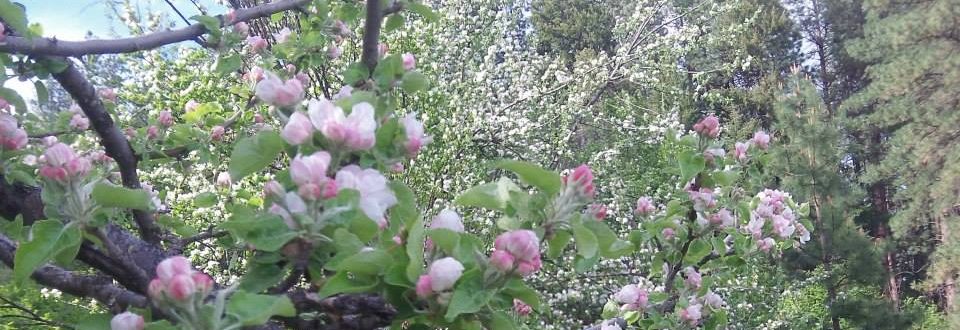I’ll never see wild fruit trees the same way, after reading Franz Vera’s ‘Grazing Ecology and Forest History’. Vera illuminates the role that thorny wild fruit trees play in forest succession, in the fertile and heavily grazed lowlands of Europe. The wild pears of my neighborhood rangeland show that hardwood forest can indeed establish under constant grazing pressure, protected by tenacious spines. I’ve seen these pear seedlings grow where not even perennial grass can survive the intense grazing.

A prevailing belief in environmentalist circles is that large grazers drive a linear kind of succession, which eventually eliminates forest and reduces biodiversity. In his book, Vera gives examples of how grazers can drive a cyclic kind of succession, which includes grasses, forbs, fruit trees, mast trees, and climax forest trees. Such dynamic habitat is of interest to me as optimal human habitat- all of our food plants, plus the maximum number of animals.
.

This resilient ecology, inherited by pastoralists from prehistoric megafauna, made the landscape which Tacitus called “bristling” in one of the earliest written accounts of Northern Europe. The “barbarians” sustained by that thorny land would eventually defeat the Roman Empire. On this continent, native and non-native thorn-bushes contribute to our local tenacity.
Vera is one of the minds behind The Oostvaardersplassen Reserve, where his theories are being put to the test. In this productive wetland, biologists were able to use proxies for extinct megafauna to improve habitat for geese. The reserve is one of the first sites in Europe to practice this kind of “rewilding”.
The management of the reserve is not without its critics. Vera takes the an uncommon position within conservation biology. He feels that the prehistoric bottomlands of Europe were forage-limited systems, rather than predator-limited systems. If this is the case, the ecological communities of these bottomlands are adapted to handle a density of herbivores limited only by the availability of food. This theory of forage-limitation is runs contrary to theories of predator limitation- which are based largely on observations of Yellowstone National Park in the U.S. At Oostvardersplassen, animal populations have been left to self-regulate, and many animals starve to death. Cullings so far have been minimal, and there are no plans to introduce hunting or non-human predators. The plant community has changed radically. Forest has receded. The grass is cropped short. There are areas of bare ground.
Critics of the Oostvardersplassen’s management take humanitarian issues with the starving animals, and have a visceral response to dying trees. Yet this is probably just the kind of radical ecological experiment that Vera hopes to learn from. And dying animals are no tragedy to the reserve’s eagles.
Watching footage aimed at shaming Oostvardersplassen’s management, I’m not so disturbed to see images of winter-killed animals, which are to be found everywhere where I live, where there are some large predators, even in the suburbs. The changes in vegetation seem drastic to me, but generally positive. There aren’t many wetlands in the world being managed to maximize the productivity of wildlife. The wetlands of my home are either drained, grazed harmfully at an artificial stocking rate, or becoming overgrown with woody vegetation.
With areas of bare soil, Oostvardersplassen is probably not optimal in terms of carbon sequestration or Holistic Management style animal productivity. There seem to be areas of improving ecological function and areas of deteriorating ecological function. But on the whole, I wonder if they have something positive and functional. Valuations in ecology are tricky.
It seems extreme to me, that reserve policy precludes hunting, which could reduce drastic population swings, and give humans an ecological connection to the reserve. At the Oxford Megafauna Conference, Sergey Zimov, of Pleistocene Park, invited attendees to join him for a barbecue- the mark of successful rewilding project. Perhaps such a backwoods attitude seems unsavory in suburban Western Europe.
Oxford Megafauna Conference presentations (including talks by Vera and Zimov)
Vera is also compelling in his comparisons of grazed “modern wood-pasture” with reconstructions of Europe’s prehistoric vegetation. Interglacial Europe seems to have exhibited mosaic vegetation. And there were dung beetles!
Vera’s book, Grazing Ecology and Forest History, was also very enlightening in a historical sense. There are fascinating accounts of how ancestral Europeans managed the land. I had no idea before reading how central “the commons” was to commoners, or how important coppiced forage was.
The book may just turn what you think you know about nature upside down. Vera looks to the African savanna as an analogue for prehistoric Europe.
“Drent and Prins (1987) found that the herbivorous fauna consumed at least 80% of the total annual production of grasses, plants and sedge every year. Elephant and buffalo account for the majority of this, i.e. 43% and 35% of the total production, respectively. With the high consumption that was observed,the number of herbivores fluctuated for about 25 years around a particular equilibrium with a biomass of approximately 175 kg ha-1.”
Imagine a world where 80% of annual plant production is cycled through animals!


